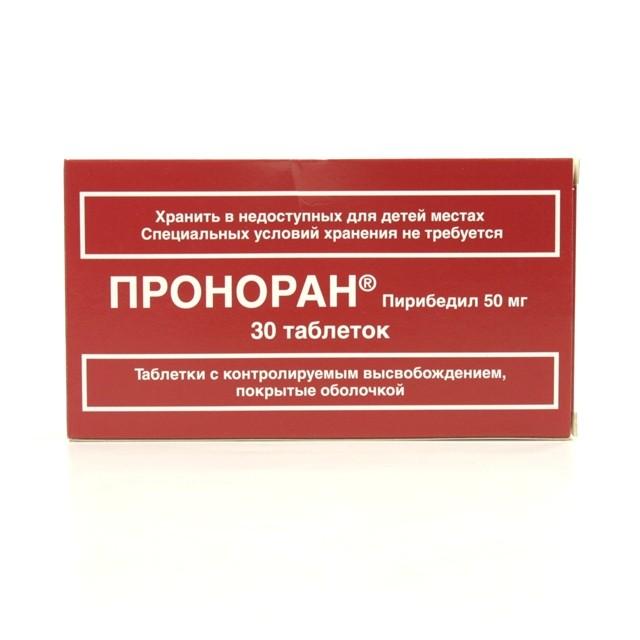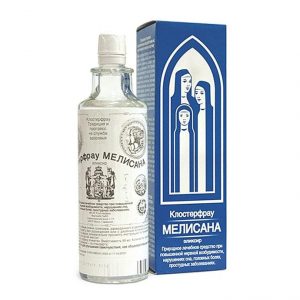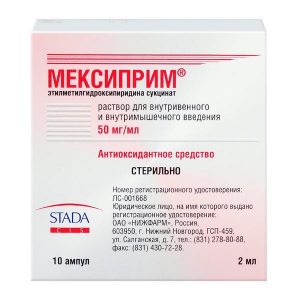Description
Release form
Tablets
Packaging
30 pcs
Pharmacological action
Pronoran has an antiparkinsonian effect.
Pharmacodynamics
The active substance pyribedil is an agonist of dopaminergic receptors. It penetrates the bloodstream of the brain, where it binds to the dopaminergic receptors of the brain, showing high affinity and selectivity for dopaminergic receptors such as D2 and D3. The mechanism of action of piribedil determines the main clinical properties of the drug for the treatment of Parkinson’s disease in both the initial and later stages of the disease with an effect on all major motor symptoms. Piribedil, in addition to acting on dopaminergic receptors, exhibits the activity of an antagonist of two major central nervous system α-adrenergic receptors (types 2A and 2C). The synergistic effect of pyribedil as an antagonist of 2 receptors and an agonist of dopaminergic brain receptors has been demonstrated in various models in animals with Parkinson’s disease: prolonged use of pyribedil leads to the development of less pronounced dyskinesia than levodopa, with a similar efficacy with respect to reversible akinesia, concomitant Parkinson’s disease.
During pharmacodynamic studies in humans, excitation of cortical electrogenesis of the dopaminergic type was shown, both on waking and during sleep, with the manifestation of clinical activity in relation to various functions controlled by dopamine, this activity was demonstrated using a behavioral or psychometric scale. In healthy volunteers, pyribedil has been shown to improve attention and alertness, related to cognitive tasks.
The effectiveness of Pronoran ® as a monotherapy or in combination with levodopa in the treatment of Parkinson’s disease was studied in three double-blind, placebo-controlled clinical trials (2 studies compared to placebo and one compared to bromocriptine). The studies involved 1103 patients of the 1-3rd stage according to the Hen and Yara scale (Hoehn & Jahr), 543 of whom received Pronoran ®.
It is shown that Pronoran ® in a dosage of 150-300 mg / day is effective in treating all motor symptoms with a 30% improvement on a unified Parkinson’s disease rating scale (UPDRS, part III – motor) for more than 7 months with monotherapy and 12 months in combination with levodopa. The improvement in the second part of the UPDRS scale – activity in everyday life – was evaluated at the same values.
In monotherapy, the statistically significant ratio of patients requiring emergency treatment with levodopa receiving pyribedil (16.6%) was less than in the group of patients receiving placebo (40.2%).
The presence of dopaminergic receptors in the vessels of the lower extremities explains the vasodilating effect of pyribedil (increases blood flow in the vessels of the lower extremities).
Pharmacokinetics
Pyribedil is rapidly and almost completely absorbed from the gastrointestinal tract and is intensively distributed.
Cmax pyribedil in blood plasma is achieved 3 6 hours after oral administration of a controlled-release dosage form. Plasma protein binding is average (unbound fraction is 20 30%). Due to the low binding of pyribedil to plasma proteins, the risk of drug interaction when used with other drugs is low.
Plasma elimination of pyribedil is biphasic and consists of an initial phase and a second slower phase, which maintains a stable concentration of pyribedil in the blood plasma for more than 24 hours.
During a combined pharmacokinetic analysis, it was shown that T1 / 2 of pyribedil after / in the introduction is an average of 12 hours and does not depend on the administered dose.
Piribedil is extensively metabolized in the liver and excreted mainly in the urine: 75% of the absorbed piribedil is excreted by the kidneys as metabolites.
Contraindications
increased individual sensitivity to pyribedil and / or excipients that are part of the drug
collapse
acute myocardial infarction
combined with antipsychotics (except clozapine)
in children under 18 years of age.
With caution: due to the fact that the preparation contains sucrose, in patients with fructose intolerance, glucose or galactose, as well as patients with a deficiency of sucrose isomaltase (a rare metabolic disorder), the drug is not recommended.
Special instructions
In some patients (especially in patients with Parkinson’s disease), while taking piribedil, sometimes a state of severe drowsiness occurs up to sudden falling asleep. This phenomenon is extremely rare, but nevertheless, patients driving a car and / or working on equipment requiring a high degree of attention should be warned about this. If such reactions occur, it is necessary to consider reducing the dose of pyribedil or discontinuing therapy with this drug.
Given the age of the population receiving piribedil therapy, the risk of falls that may be caused by sudden falling asleep, hypotension, or confusion should be considered.
Patients and their guardians should be warned of possible symptoms of a behavioral disorder (addiction to gambling, increased libido and hypersexuality, an obsessive desire to shop, and compulsive overeating). If such symptoms occur, it is necessary to consider reducing the dose or gradually stopping the drug.
Crimson dye, which is part of the drug, in some patients increases the risk of an allergic reaction.
Impact on the ability to drive vehicles and mechanisms. Patients with episodes of severe drowsiness and / or sudden falling asleep during pyribedil therapy should refrain from driving vehicles and equipment requiring a high degree of attention until these reactions disappear.
Composition
Active ingredient: pyribedil 50 mg
Excipients: magnesium stearate – 5 mg povidone – 20 mg talc – 130 mg
Shell: carmellose sodium ² 0.71 mg polysorbate 80 ² 0.3 mg dye crimson Ponceau 4R 4 , 87 mg povidone – 6.31 mg sodium bicarbonate – 0.15 mg silicon colloidal dioxide – 0.27 mg sucrose – 57.17 mg talc – 50.37 mg titanium dioxide – 0.78 mg white beeswax – 0.07 mg
Dosage and administration
Inside, after eating, without chewing, with 1/2 glass of water.
For all indications, except Parkinson’s disease, 50 mg (1 tablet) once a day. In more severe cases, 50 mg 2 times a day.
Parkinson’s disease: monotherapy – from 150 to 250 mg (3 to 5 tablets) per day, it is recommended to divide into 3 doses, if necessary, take the drug at a dose of 250 mg, it is recommended to take 2 tablets of 50 mg in the morning and afternoon and 1 tablet in the evening in combination with levodopa preparations – 150 mg (3 tablets) per day, it is recommended to divide into 3 doses.
When selecting a dose in case of its increase, it is recommended to titrate the dose, gradually increasing it by 1 tablet (50 mg) every 2 weeks.
Side effects of
From the gastrointestinal tract: minor gastrointestinal symptoms (nausea, vomiting, flatulence), these adverse reactions are reversible in the selection of the appropriate individual dose. Dose selection by gradually increasing the dosage (50 mg every 2 weeks until the recommended dose is achieved) leads to a significant reduction in the manifestation of these side effects.
From the side of the central nervous system: mental disorders, such as confusion, hallucinations, agitation or dizziness, disappearing when the drug is canceled.
Taking piribedil is accompanied by drowsiness and, in extremely rare cases, may be accompanied by severe drowsiness in the daytime, until sudden falling asleep.
From the CCC side: hypotension, orthostatic hypotension with loss of consciousness or malaise, or blood pressure lability.
Allergic reactions: risk of allergic reactions to crimson dye, part of the drug.
Drug Interactions
Due to the mutual antagonism between dopaminergic antiparkinsonian drugs and antipsychotics, concurrent administration with antipsychotics (except clozapine) is contraindicated.
1. Patients with extrapyramidal syndrome caused by the use of antipsychotics should be prescribed anticholinergic drugs and dopaminergic antiparkinsonian drugs should not be prescribed (due to the blocking of dopaminergic receptors by antipsychotics).
2. Dopaminergic anti-Parkinsonian drugs can cause or exacerbate psychotic disorders. If prescribing antipsychotics is required for patients with Parkinson’s disease, receiving treatment with dopaminergic antiparkinsonian drugs, the dose of the latter should be gradually reduced until the final withdrawal (sudden cancellation of dopaminergic drugs is associated with the risk of developing malignant antipsychotic syndrome).
3. Antiemetic antipsychotics (antiemetic drugs that do not cause extrapyramidal symptoms should be used).
Due to the mutual antagonism between dopaminergic antiparkinsonian drugs and tetrabenazine, the simultaneous administration of these drugs is not recommended.
The use of pyribedil in conjunction with alcohol is not recommended.
Caution should be exercised when prescribing pyribedil with other drugs with a sedative effect.
Overdose
Symptoms: vomiting, which is due to the action on the chemoreceptor trigger zone, blood pressure lability (increase or decrease), impaired gastrointestinal function (nausea, vomiting).
Treatment: drug withdrawal, symptomatic therapy.
Storage Conditions
The product should be stored at a temperature not exceeding 30 ° C.
Term hodnosty
3 years
active substance
Piribedil
Terms leave around drugstore
prescription
Dosage form
tablet prolong.
Servier, France




